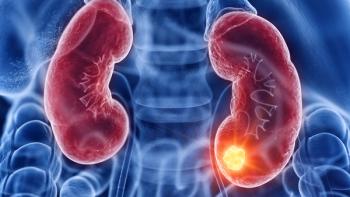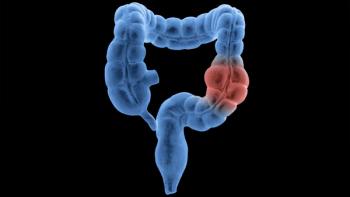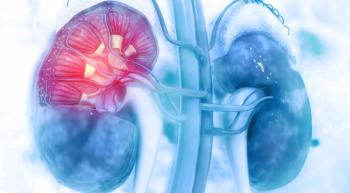
Subcutaneous vs IV Pertuzumab/Trastuzumab Provide Similar Efficacy, Safety in HER2+ Breast Cancer
Patients with HER2-positive early breast cancer derived similar outcomes whether they received subcutaneous or intravenous pertuzumab and trastuzumab plus chemo.
Subcutaneous pertuzumab (Perjeta) and trastuzumab (Herceptin) plus chemotherapy given in the neoadjuvant setting for patients with HER2-positive early breast cancer demonstrated similar efficacy and safety compared with intravenous pertuzumab/trastuzumab plus chemotherapy, according to long-term data from the final analysis of the phase 3 FeDeriCa trial (NCT03493854).
Findings presented at the 2024 ESMO Breast Cancer Congress showed that at a median follow-up of 51.4 months in the IV arm and 51.2 months in the subcutaneous arm, more than 80% of patients in both arms completed the adjuvant phase.
In evaluable patients who underwent surgery and received the subcutaneous combination (n = 234) vs those who received the IV combination (n = 239), similar efficacy outcomes between the groups were observed for invasive disease-free survival (iDFS; HR; 1.20; 95% CI, 0.68-2.11). Furthermore, in all patients in the subcutaneous arm (n = 248) and IV arm (n = 252), comparable outcomes were reported for event-free survival (EFS; HR, 1.20; 95% CI, 0.72-1.98), distant recurrence–free interval (DRFI; HR, 1.17; 95% CI, 0.61-2.24), and overall survival (OS; HR, 1.26; 95% CI, 0.58-2.72).
“Overall, these findings support the primary analysis results,” lead author, Christian Jackisch, MD, PhD, and colleagues, wrote in a poster presentation of the data. “Pertuzumab/trastuzumab subcutaneous fixed-dose combination is established as a faster, more convenient, less invasive, patient- and health care professional–preferred alternative to IV pertuzumab/trastuzumab for patients with HER2-positive breast cancer.”
Jackisch serves as the head of the Department of the Gynecology and Obstetrics and chair of the Breast Cancer Center and Gynecologic Cancer Center at Academic Hospital Sana Klinikum Offenbach in Germany; he is also a senior lecturer at Phillips-University Marburg in Germany.
Previously reported findings from the primary analysis of FeDeriCa demonstrated that the serum trough concentration (Ctrough) after cycle 7 of subcutaneous pertuzumab/trastuzumab given in a fixed-dose combination was non-inferior to that of the IV formulations, meeting the primary end point. Furthermore, both regimens generated similar pathological complete response rates and had comparable safety profiles in line with what was previously known about pertuzumab/trastuzumab.
A safety analysis conducted during the adjuvant phase of the study also indicated that the overall safety and tolerability of the subcutaneous injection regimen were comparable to those of the IV regimen. The only differences in adverse effects (AEs) were related to the different routes of administration.
FeDeriCa enrolled patients with HER2-positive, operable, locally advanced or inflammatory stage II to IIIC breast cancer. Notably, a left ventricular ejection fraction (LVEF) of at least 55% was required.
Eligible patients were randomly assigned 1:1 between the 2 arms. Patients received 8 cycles of neoadjuvant chemotherapy using 1 of 2 standard regimens chosen by the investigator in combination with IV pertuzumab given as an 840 mg loading dose then 420 mg maintenance and IV trastuzumab at 8 mg/kg as a loading dose then 6 mg/kg maintenance; or subcutaneous pertuzumab at 1200 mg and trastuzumab at 600 mg, followed by a fixed-dose combination of 600 mg each every 3 weeks during cycles 5 through 8.
Following surgery, patients continued adjuvant HER2-targeted treatment as per randomization to complete 18 cycles. From cycle 9 onward, those continuing with IV pertuzumab could switch from IV trastuzumab to subcutaneous trastuzumab, at the investigator's discretion, if the subcutaneous formulation was routinely used in a given patient’s country.
The final analysis assessed secondary end points including iDFS; iDFS including second primary non–breast cancer; EFS; EFS including second primary non–breast cancer; DRFI; OS; and safety with a focus on cardiac AEs. Exploratory end points included pertuzumab Ctrough and trastuzumab Ctrough during cycle 12 (post-surgery cycle 13) to demonstrate the non-inferiority of cycle 12 pertuzumab Ctrough of subcutaneous pertuzumab within pertuzumab/trastuzumab fixed-dose combination vs IV pertuzumab; and trastuzumab Ctrough of subcutaneous trastuzumab within pertuzumab/trastuzumab fixed-dose combination vs IV trastuzumab.
Additional data showed that the mean and geometric mean of cycle 12 Ctrough were higher in the subcutaneous arm for both pertuzumab (geometric mean ratio, 12.5; 90% CI, 1.17-1.33) and trastuzumab (geometric mean ratio, 1.39; 90% CI, 1.29-1.50).
Regarding cumulative safety data from neoadjuvant and adjuvant treatment, in the subcutaneous group (n = 248), all patients experienced an any-grade AE. Additionally, 53.2% experienced grade 3 or higher AEs and 19.8% had serious AEs. Cardiac AEs were reported in 21.0% of patients, with 1.2% experiencing grade 3 or higher cardiac AEs.
Anaphylaxis/hypersensitivity reactions were noted in 1.2% of patients in the subcutaneous group, all of which were grade 3 or higher, and systemic reactions occurred in 0.4% of patients. Local site reactions were reported in 14.9% of patients, with no grade 3 or higher local site reactions. AEs led to study drug discontinuation in 8.9% of patients and HER2-targeted therapy discontinuation in 4.8% of patients. Finally, AEs led to chemotherapy drug discontinuation in 5.6% of patients.
In the IV group (n = 252), 99.6% of patients experienced an any-grade AE. Grade 3 or higher AEs were reported in 60.3% of patients, and serious AEs occurred in 20.6% of patients. Cardiac AEs were reported in 25.8% of patients, with 3.2% experiencing grade 3 or higher cardiac AEs.
Anaphylaxis/hypersensitivity reactions were seen in 1.2% of patients, all of which were grade 3 or higher. Systemic reactions occurred in 11.1%, with 0.8% of patients experiencing grade 3 or higher systemic reactions. Local site reactions were rare, occurring in 0.4% of patients, with no grade 3 or higher local site reactions. Study drug discontinuation due to AEs was reported in 12.7% of patients and HER2-targeted therapy discontinuation occurred in 6.0%. AEs led to chemotherapy drug discontinuation in 9.1%.
Primarily focusing on cardiac events during the adjuvant phase, in the subcutaneous group, 0.8% of patients experienced a primary cardiac event, specifically, heart failure and significant LVEF decline were reported in 0.8% of patients. There were no cardiac deaths in this group. Secondary cardiac events were noted in 3.2% of patients, all identified by initial LVEF assessments, with none confirmed by a second LVEF assessment. In the IV group, 1 patient experienced a primary cardiac event—specifically heart failure and significant LVEF decline. This group also reported 1 cardiac death. Secondary cardiac events were identified in 6.0% of patients.
In the subcutaneous group, which consisted of a subset of patients who switched to this treatment (n = 65), no primary cardiac events, heart failure with significant LVEF decline, or cardiac deaths were reported. Secondary cardiac events were identified in 6.2% of patients.
Regarding cardiac safety data during the follow-up phase in the subcutaneous group, no primary cardiac events were reported. This group did not experience any cases of heart failure with significant LVEF decline, nor were there any cardiac deaths. However, secondary cardiac events were reported in 4.0% of patients, and all these events were identified by initial LVEF assessments, with 1.6% confirmed by a second LVEF assessment.
For the IV group, 1 patient experienced a primary cardiac event, specifically heart failure with significant LVEF decline. No cardiac deaths were reported in this group. Secondary cardiac events were identified in 6.0% of patients, all through initial LVEF assessments, with 3.6% confirmed by a second LVEF assessment.
Reference
Jackisch C, Im S, Mattar A, et al. Fixed-dose combination of pertuzumab and trastuzumab for subcutaneous injection (PH FDC SC) plus chemotherapy in HER2-positive early breast cancer (EBC): Long-term efficacy and safety analysis of the randomised, open-label, multicentre phase III (neo)adjuvant FeDeriCa study. Presented at: 2024 ESMO Breast Cancer Congress; May 15-17, 2024; Berlin, Germany. Abstract 114P.
Newsletter
Knowledge is power. Don’t miss the most recent breakthroughs in cancer care.

























































































